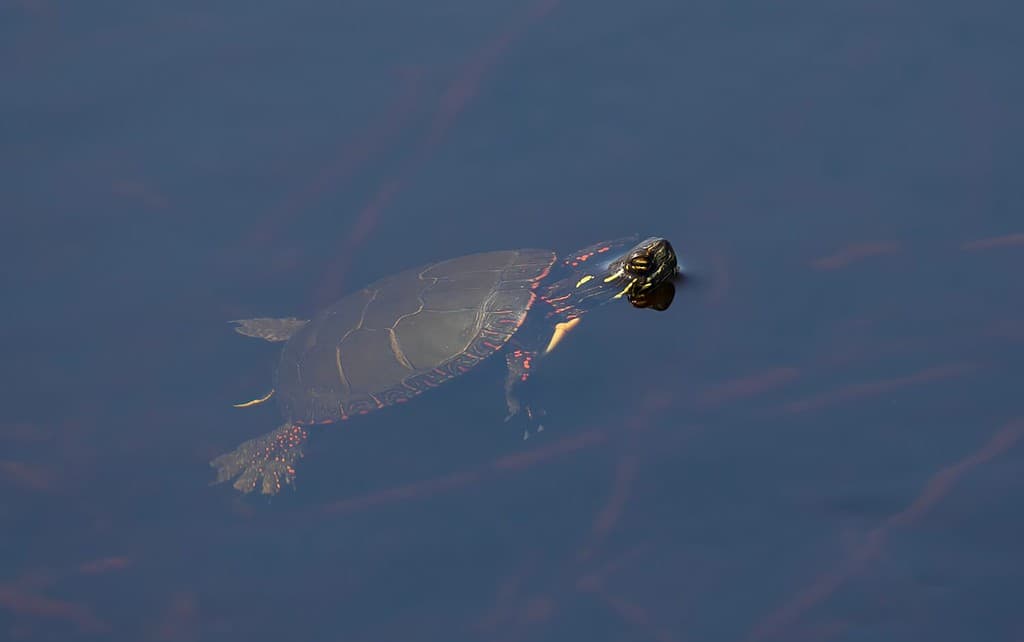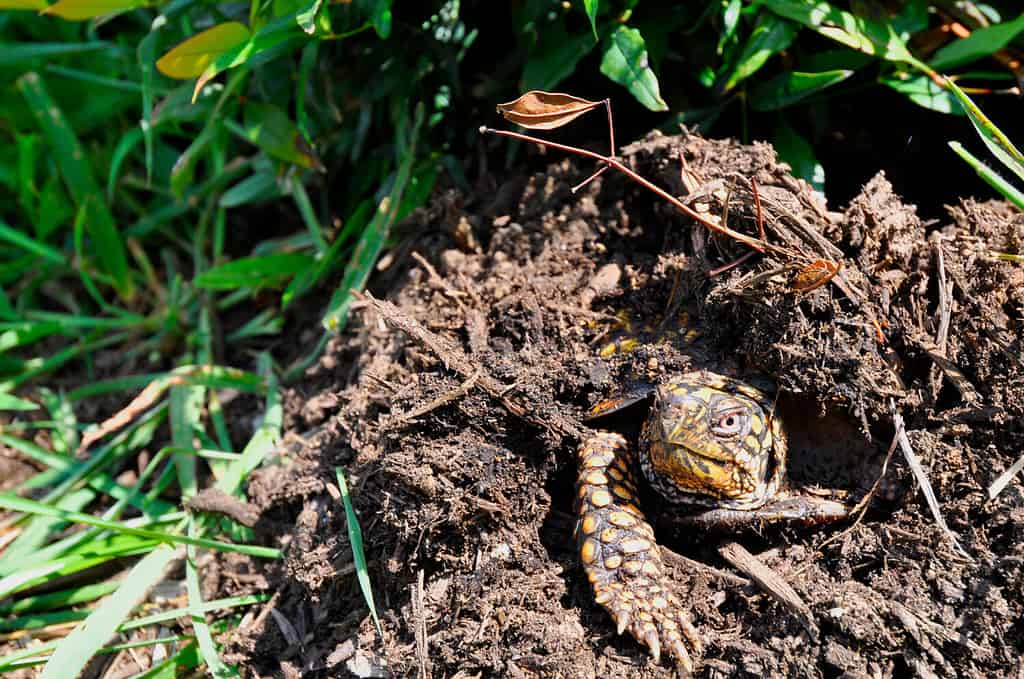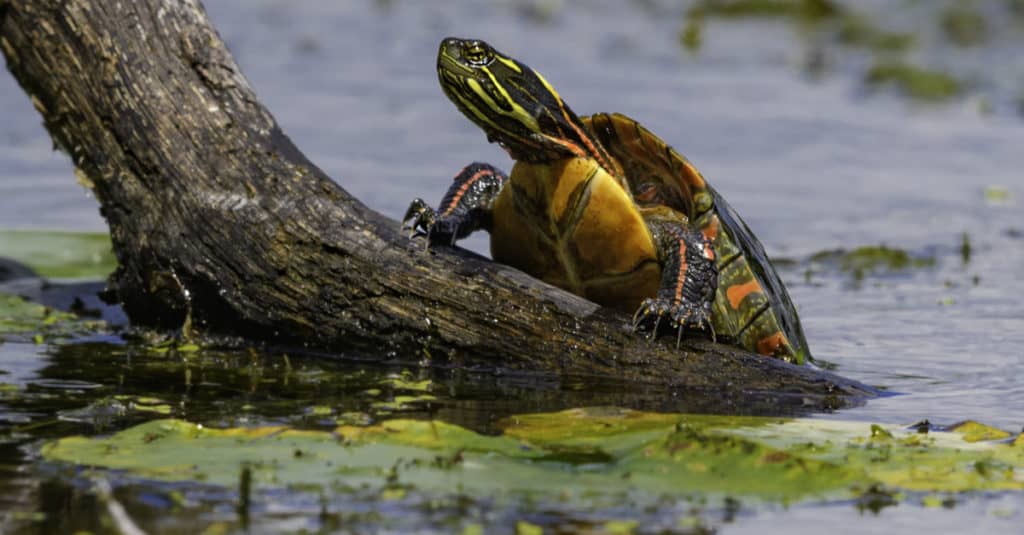Turtles do not hibernate in the same way that other animals do but they do bury themselves in mud or leaves to stay warm during the colder months. As the temperature drops, they become less active to slow down their metabolism and survive the winter. This process is called brumation. It can occur on land or under the water, even if it is frozen over on top. Depending on the location, some species remain somewhat active moving around under the water during the winter. Others are much more reserved and conserve their energy. They try to avoid extremely cold temperatures and will seek out warmer spots when possible.
Where Do Turtles Go in the Winter?

Many turtles spend the winter underwater to keep warm.
©Jim Cumming/Shutterstock.com
Turtles go into the water and look for warm spots, such as muddy areas, where they can bury themselves. They generally try to stay in water that doesn’t freeze, although, in some places, it can’t be avoided. These reptiles are cold-blooded and they need to stay in environments that are warm enough to keep their body temperatures regulated. In the summer months, they have plenty of options for getting warm and staying cool. But in the colder winter months, they have to seek out places that are warm enough.
Some turtles brumate on land. They look for protected tree stumps, abandoned burrows that other animals use, or any other place that provides protection from potential predators and keeps them warm. They generally dig a couple of feet into leaves, dirt, or other de
How Long Do Turtles Hibernate in the Winter?

The cold-blooded turtle is a reptile rather than a mammal and relies on the environment to regulate its body temperature.
©Kurit afshen/Shutterstock.com
The time that a turtle will seek shelter depends on the climate where they live. In some areas, turtles go into their own version of hibernation for up to 8 months out of the year. It is closely tied to the weather and climate, especially temperature.
When turtles burrow down into the mud and go into their version of hibernation, they also experience a rapid shift in their metabolism. They don’t need to eat much and can even go months without food. They can survive without coming up for oxygen for a long time as well. When turtles seek shelter under icy water, it further reduces the available oxygen in the environment. Ideally, turtles are able to find just the right spot that still has some oxygen coming in, often a spring or moving body of water.
It’s important to note that turtles don’t actually hibernate during these months so don’t be surprised to see them moving around a bit under the water. This may be due to a change in the environment which requires them to burrow deeper or find a new place to shelter. A big part of what makes their shelter effective is that it protects them from predators during this period of decreased activity. If it no longer does that, the turtle knows that it needs to find a new place to wait out the colder weather.
What Months Do Turtles Hibernate?

Turtles bury themselves in leaves, mud, dirt, and other debris to use as insulation against the cold.
©Keri Delaney/Shutterstock.com
Turtles go into their burrows in the winter months, typically around the first frost or before. As temperatures dip, turtles look for a cozy, safe place to spend the winter months. They dig underwater into the mud or look for safe places in tree stumps or other animals’ discarded burrows on land. Many species prefer underwater burrows, however, because they can stay warmer. Staying on land means colder temperatures but turtles counter that by digging into leaves and other debris to provide insulation. A land-based burrow allows them greater access to oxygen.
Once the temperatures warm up, turtles come out of brumation and begin to look for food. This typically occurs when the water temperatures reach the mid-60s. This often happens around April, although the exact time varies by location.
Can Turtles Survive Cold Winters?

When the temperatures warm up, turtles who made it through the winter look for food and fresh air.
©FotoRequest/Shutterstock.com
Most turtles will go into the water to make it through cold winters. Only a few species can survive being frozen so most will go below the line of ice in ponds and lakes to make it through cold weather. Even under the water, it’s hard to survive with scarce food and oxygen.
One feature that turtles have to help them survive the winter is actually their shell. While we all are familiar with the protection that the turtle’s shell provides, it also helps counter the build-up of harmful byproducts of living in a carbon dioxide-rich environment for a long time.
Sea turtles are especially vulnerable to cold conditions. If they are exposed to cold temperatures for a long time, they can become cold-stunned. This means that they become lethargic and inactive. Some species will actually migrate to warmer waters, seek out warm spots in deeper water, or burrow into the mud like other turtles. Sea turtles live in tropical areas that do not experience the same cold temperatures in other parts of the world. When unusually cold winter weather hits a normally warm location, however, the sea turtle population can be significantly impacted.
The photo featured at the top of this post is © samray/Shutterstock.com
Thank you for reading! Have some feedback for us? Contact the AZ Animals editorial team.







